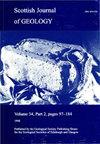Aspects of Aktuo-Paläontologie of the rocky beaches of the eastern Isle of Mull, UK
IF 1.3
4区 地球科学
Q4 GEOLOGY
引用次数: 0
Abstract
Conglomerates are, commonly, only poorly fossiliferous at best. Yet beaches with common lithic clasts can be used to model the taphonomy of fossils in conglomeratic settings. Four beaches on the east coast of the Isle of Mull, Inner Hebrides, are clast-rich, with lithic pebbles, cobbles and boulders, but poor in shells, many of which are poorly preserved. There is ample evidence of shells being bored and encrusted, yet many or most of these were infested after death of the host. Of the ‘boring trinity’ – Caulostrepsis Clarke, Entobia Bronn and Gastrochaenolites Leymerie – so typical of the Trypanites Ichnofacies around Britain's coasts, only the last ichnogenus was not present, most likely due to the absence of suitable mobile substrates (such as limestone cobbles and oysters). Encrusters including Balanus , serpulids and spirorbids, show different patterns of preservation, probably due to multiple factors. Bored wood ( Apectoichnus ) was only found at one locality, which may be due to hydrodynamic sorting. Whelk shells show a range of patterns of breakage, most probably due to mechanical damage. But conglomerates commonly preserve fossil snails either complete or not at all. The results from these sites suggest that they represent an intermediate condition rarely preserved in the rock record.英国马尔岛东部岩石海滩Aktuo-Paläontologie的各个方面
一般来说,砾岩最多只能形成很差的化石。然而,具有共同岩屑碎屑的海滩可以用来模拟砾岩环境中的化石地貌学。内赫布里底群岛(Inner Hebrides)马尔岛(Isle of Mull)东海岸的四个海滩上,碎屑丰富,有鹅卵石、鹅卵石和巨石,但贝壳很少,其中许多保存得很差。有充分的证据表明,这些贝壳被钻穿和结壳,但其中许多或大部分在寄主死后被侵染。在“无聊的三位一体”——Caulostrepsis Clarke, Entobia Bronn和Gastrochaenolites Leymerie——是英国海岸周围典型的锥虫鱼相,只有最后一个鱼属没有出现,很可能是由于缺乏合适的可移动基质(如石灰石鹅卵石和牡蛎)。包括Balanus, serpulids和spirorbids在内的壳体呈现出不同的保存模式,可能是由于多种因素的影响。钻孔木(Apectoichnus)只在一个地方发现,这可能是由于水动力分选。海螺壳呈现出一系列破碎的模式,很可能是由于机械损伤。但是,砾岩通常保存完整的蜗牛化石,或者根本不保存。这些遗址的结果表明,它们代表了一种中间状态,很少在岩石记录中保存下来。
本文章由计算机程序翻译,如有差异,请以英文原文为准。
求助全文
约1分钟内获得全文
求助全文
来源期刊

Scottish Journal of Geology
地学-地质学
CiteScore
1.70
自引率
0.00%
发文量
10
审稿时长
>12 weeks
期刊介绍:
Although published only since 1965, the Scottish Journal of Geology has a long pedigree. It is the joint publication of the Geological Society of Glasgow and the Edinburgh Geological Society, which prior to 1965 published separate Transactions: from 1860 in the case of Glasgow and 1863 for Edinburgh.
Traditionally, the Journal has acted as the focus for papers on all aspects of Scottish geology and its contiguous areas, including the surrounding seas. The publication policy has always been outward looking, with the Editors encouraging review papers and papers on broader aspects of the Earth sciences that cannot be discussed solely in terms of Scottish geology.
The diverse geology of Scotland continues to provide an important natural laboratory for the study of earth sciences; many seminal studies in geology have been carried out on Scottish rocks, and over the years the results of much of this work had been published in the Journal and its predecessors.
The Journal fully deserves its high reputation worldwide and intends to maintain its status in the front rank of publications in the Earth sciences.
 求助内容:
求助内容: 应助结果提醒方式:
应助结果提醒方式:


